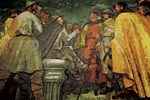Carantania and the Enthronement of Princes
7th to 11th century:
The Duchy of Carantania, the oldest known
independent Slavonic state in this area

In the 4th and 3rd centuries BC, the territory of the present-day Slovenia was occupied by Celtic tribes, which formed the first state called Noricum. Around 10 BC, Noricum was annexed by the Roman Empire and Roman cities started to appear, among them Emona (Ljubljana), Celeia (Celje) and Poetovia (Ptuj). Under the Roman Empire, the population became Romanized and Christianity began to assert itself. In the 5th and 6th centuries, the area was exposed to invasions by the Huns and Germanic tribes during their incursions into Italy.
After the departure of the last Germanic tribe - the Langobards - to Italy in 568, Slavs began to dominate the area, but it is not quite clear as to exactly when they first arrived here. After the resistance against the nomadic Asian Avars (from 623 to 626), this Slavonic people united with King Samo's tribal confederation, which had its centre in the present Czech Republic.
The confederation fell apart in 658 and the Slav people on the territory of the present-day Carinthia formed the independent duchy of Carantania, with its centre at Krn Castle, north of Klagenfurt. From this period onwards, until 1414, a special ceremony of the enthronement of princes, conducted in Slovenian, took place.In the middle of the 8th century, Carantania became a vassal duchy under the rule of the Bavarians, who began to spread Christianity. In 788, Carantanians together with Bavarians came under Frankish rule. At the beginning of the 9th century, the Franks removed the Carantanian princes because of rebellions, replacing them with their own border dukes. The Frankish feudal system started spreading to Slovenian territory.
At the end of the 9th century, Magyars invaded the Pannonian Plain. They intruded into Slovenian territory and cut it off from the other western Slavs.Thus the isolated Slavs of Carantania and of Carniola to the south, started developing into an independent nation of Slovenes. After the victory of Emperor Otto I over the Magyars in 955, Slovenian territory became divided into a number of border regions of the Holy Roman Empire, the most important of which, Carantania, was in 976 elevated into the duchy of Great Carantania. The Freising Manuscripts date from this period - a few prayers written in the Slovenian language of the time. In the late Middle Ages, the historic states of Štajerska (Styria), Koroška (Carinthia), Kranjska (Carniola), Gorizia, Trieste and Istria were formed from the border regions and included in the medieval German state.
More information:
